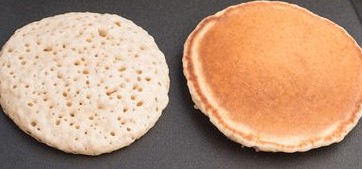Creating Perfect Pancakes for Your Family Breakfast
TEXARKANA, Ark. –
It’s a rare occasion when both of my kids are home at the same time for me to fix them breakfast anymore, but when they are, I prefer to make blueberry pancakes. There is something about a stack of warm, buttery, sweet and sticky pancakes.
Is there a trick to cooking the perfect pancake? Yes! Use a hot griddle but not as hot as a lot of recipes tell you. If it is too hot, you burn the outside of the pancake while the inside is raw, and no one wants to eat that. Try using a medium-high heat setting.
Not only is the griddle important, so is the spatula, or flipper as some call it. It should be wide. This will help you lift the pancake properly and turn it over. If you spatula is too small, the batter will slide off the sides and create an ugly pancake, not to mention frustration for the cook.
Some say to heat your griddle until a drop of water dances across the pan. This is ok as long as the griddle isn’t too hot. Once the griddle is hot enough, lightly coat it with non-stick cooking spray, vegetable oil, or clarified butter. Using regular butter will burn quickly and you will get dark pancakes.
Start by trying out one pancake and adjust the temperature up or down, depending upon what your pancake looks like. If your pancake is scorched on the outside and raw on the inside, turn down the heat.
When you're satisfied that you've reached the perfect pan temperature, ladle in as many pools of batter as your pan will comfortably hold. A good tip to perfectly sized pancakes is to use a dry measuring cup or ladle. I like to use a one fourth cup dry measuring cup. All pancakes will be the same size and cook at the same amount of time. Leave a little room between pancakes for comfortable flipping.
Knowing when to turn the pancakes is critical to perfect pancakes. A pancake is ready to be turned over when it's dry around the edges and bubbles have formed over the top. If possible, peek to see if the bottom is golden brown before you flip it. When cooking the second side, DO NOT press down the pancake with your spatula. Pressing down will not make it cook any faster, but will delete all the effort you have made to have light, fluffy pancakes.
Pancakes are best eaten fresh from the griddle. If you absolutely must wait for all the pancakes to be done before serving, arrange them in a single layer on a baking sheet and place them, uncovered, in a warm oven. Never stack or cover them; the steam escaping from the pancakes will make them soggy.
Although the classic topping for pancakes is margarine and syrup, create a condiment bar and let your family choose their own toppings. At my house, blueberries that I have picked at the local farm are the choice. Other fresh fruit choices are apple slices, sliced strawberries, bananas and any other fresh fruit you desire.
Remember that pancakes are in the grain group and provide us with valuable vitamins and minerals that we need. Experiment with different flours such as whole wheat, gluten free, rice, self-rising and cake flour. It’s important to realize that each type of flour will yield a different pancake texture and taste.
This is my recipe for Fluffy Blueberry Pancakes. They are light, fluffy and so yummy.
Fluffy Blueberry Pancakes
1 1/4 cup all-purpose flour
1/2 teaspoon salt
1 tablespoon baking powder
1 1/4 teaspoons white sugar
1 egg
1 cup milk
1/2 tablespoon butter, melted
1/2 cup fresh or frozen blueberries
In a large bowl, sift together flour, salt, and baking powder; add sugar. In a small bowl, beat together egg and milk. Gently stir milk and egg into flour mixture. Gradually add butter.
Heat a lightly oiled griddle over medium high heat. Ladle one half cup of batter onto griddle, sprinkle with some of the blueberries. As soon as bubbles begin to form, turn over. Brown on both sides and serve hot with butter and warm syrup.
For more information, contact the Miller County Extension Office, 870-779-3609 or visit us in room 215 at the Miller County Courthouse. We're online at cdue@uada.edu, on Facebook and Twitter @MillerCountyFCS or on the web at uaex.uada.edu/Miller.
Tried and True Tip:
Mixing frozen blueberries into the batter before scooping will turn it blue and streaky.
By Carla Due
County Extension Agent - FCS
The Cooperative Extension Service
U of A System Division of Agriculture
Media Contact: Carla Due
County Extension Agent - FCS
U of A Division of Agriculture
Cooperative Extension Service
400 Laurel Street, Suite 215 Texarkana AR 71854
(870) 779-3609
cdue@uada.edu
Related Links
The Arkansas Cooperative Extension Service is an equal opportunity institution. If
you require a reasonable accommodation to participate or need materials in another
format, please contact your County Extension office (or other appropriate office)
as soon as possible. Dial 711 for Arkansas Relay.
Pursuant to 7 CFR § 15.3, the University of Arkansas System Division of Agriculture
offers all its Extension and Research programs and services (including employment)
without regard to race, color, sex, national origin, religion, age, disability, marital
or veteran status, genetic information, sexual preference, pregnancy or any other
legally protected status, and is an equal opportunity institution.
